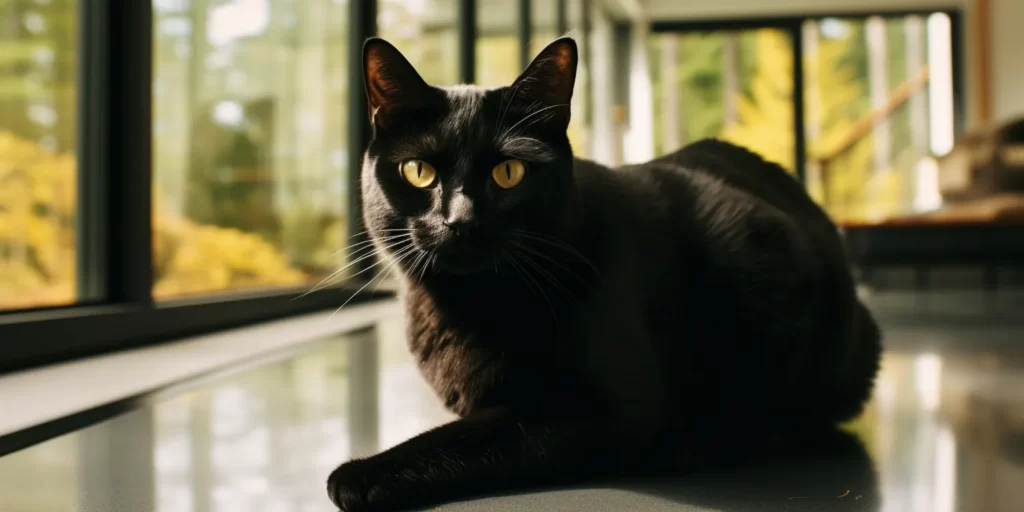Welcome to the melodious realm of Bombay cats, where their vocal cords are just as expressive as their captivating, sleek black coats. If you’ve ever wondered whether these mysterious-looking felines are as vocal as their stares seem to suggest, you’re about to dive into an exploration of Bombay cat noises.
Bombay cats are known for their affectionate nature and deep bonding with their owners, which is reflected in their tendency to use their voice to seek attention. Whether they’re chirping, meowing, or purring, these cats have much to say and prefer to have ongoing “conversations” with their human family.
Unlike the quiet whispers of some other breeds, the Bombay cat’s vocal expressions are a central part of their charm and personality. Not only do these social butterflies crave interaction, but they also seem to understand that their voices are a powerful tool to ensure they’re never left out of the loop.
For anyone seeking a silent, shadow-like pet, a Bombay cat may not be the best fit. Their penchant for vocalization is matched only by their desire for companionship, making them the perfect pet for those who enjoy engaging in back-and-forth banter with their furry friends.
But what exactly influences these noisy behaviors, and how can you understand the symphony of sounds your Bombay cat produces? Let’s explore the world of Bombay cat vocalizations together and find out!

Are Bombay Cats Vocal?
Yes, Bombay cats are indeed vocal creatures. Their vocal nature is a distinguishing characteristic that makes them unique among felines. While some may think a cat’s gender affects its noise level, in Bombay cats, both males and females are equally prone to expressing themselves through sound.
It’s true that individual Bombay cats may vary in how much they vocalize, but as a breed, they tend to be more expressive than most.
Some people might notice that their Bombay cats are more vocal at certain times of the day, usually correlating with periods of high activity or when they are seeking attention. Interestingly, while more active cats might be expected to make less noise, Bombay cats defy this assumption by using their vocalizations as a method of interaction, whether they’re in motion or curled up beside you.
The bond that Bombay cats form with their owners is a significant factor in their vocal behavior. They’re not simply making noise; they’re communicating. Whether they’re commenting on their day, asking for food or affection, or just saying “hello,” their sounds are a big part of how they interact with the world around them.
Factors That Influence Bombay Cat Noise Levels
Different factors can play a role in how vocal a Bombay cat might be. Understanding these can help you better connect with your feline and ensure their needs are met.

Their Age
Younger Bombay kittens tend to be more vocal as they explore their environment and learn to communicate their needs and desires. As they grow, they may maintain their talkative nature, using their voices to interact with their human companions.
The aging process can also influence their vocal patterns, with senior Bombay cats possibly becoming either more vocal due to health issues or less so as they settle into their golden years with a more reserved demeanor.
Feeding Bombay Cats and Its Relation to Noise Levels
Mealtime is a significant event in the life of a Bombay cat, and they won’t hesitate to remind you when it’s time to eat. A regular feeding schedule helps keep their vocal demands in check, as they learn to anticipate when food is coming.
Conversely, an erratic feeding schedule might result in a Bombay cat becoming more vocal, as they’ll feel the need to communicate their hunger more frequently and emphatically.
Bombay Cat Exercise Level Affects Their Noise Levels
While it might seem counterintuitive, Bombay cats’ vocalizations aren’t necessarily linked to their activity levels in the way one might expect. These cats use their voices as a form of engagement and interaction, regardless of whether they’re currently engaged in play.
However, providing enough mental and physical stimulation can help reduce stress-related vocalizing, as a content and tired cat is less likely to vocalize out of boredom or anxiety.
Medical Conditions
Sometimes, a change in a Bombay cat’s vocal behavior can signal underlying health issues. Increased or distressed meowing might indicate pain, discomfort, or the onset of a medical problem.
It’s essential to pay attention to any significant changes in vocalization patterns and consult with a veterinarian to rule out health concerns.
Bombay Cat Noises and Their Meaning
Understanding the spectrum of noises your Bombay cat makes is not just a part of pet ownership; it deepens the bond between you and your feline friend.
Each sound carries its own message, and knowing what they’re trying to tell you is a big step in caring for them properly.
Meow (The Most Common Noise)
The meow is the Bombay cat’s Swiss Army knife of sounds, used for everything from greeting you at the door to letting you know it’s time for their next meal.
The tone, duration, and frequency of meows can convey excitement, demand attention, or express curiosity.
Purring (The Most Enjoyable Cat Noise)
Purring is a deep, rumbling sound that signifies contentment and comfort. It’s often heard when your Bombay cat is relaxing or receiving affection but can also be a self-soothing behavior during times of stress or illness.
Hissing (Your Cat Feels In Danger)
A hiss is a clear indication of fear, discomfort, or territoriality. If your Bombay cat hisses, it’s crucial to identify and remove the source of their distress to help them feel safe again.

Yowl (Not a Happy Meow)
A yowl is a loud, drawn-out sound that can denote discomfort, loneliness, or desire for attention. A Bombay cat might yowl to find you in the house or express unease about something in their environment.
Growls (Not as Scary as a Tiger)
Growling is a low sound that usually means your Bombay cat feels threatened or is experiencing a deep annoyance. It can precede or accompany a hiss in situations of heightened stress or anger.
Some Cats are More Talkative Than Others
While Bombay cats, in general, are known for their vocal nature, it’s essential to remember that each cat is an individual. Some may be more inclined to “chat” than others, depending on their personality, age, and overall demeanor.
Observing and responding to your cat’s vocal cues can help you understand their specific communication style and needs.
How to Make Bombay Cats Less Vocal?
If you’re finding your Bombay cat’s vocalizations overwhelming, there are ways to gently address this behavior. Ensuring they have plenty of playtime and interaction can meet their social needs, reducing their need to vocalize for attention.
Establishing a regular routine for feeding and play can provide a sense of security and reduce anxiety-driven meowing.
Lastly, creating a calm environment and paying close attention to their communication can help you understand what they need, potentially reducing the frequency and urgency of their calls.

Conclusion
The vocal nature of Bombay cats is just one of the many traits that make them such captivating companions. Their array of sounds—from meows and purrs to chirps and growls—enriches the lives of those who choose to share their homes with these glossy black beauties. Understanding and appreciating the nuances of Bombay cat noises can bring you closer to your feline friend, making the journey of pet ownership an even more rewarding experience.